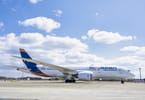The recent reports of International Air Transport Association (IATA) for June shows a promising rise in air freight demand in the global aviation industry. The figures show a 1.2% year-on-year expansion in air freight demand. Although weak, this is an improvement when compared to the 0.9% year-on-year demand growth recorded in May and the 0.1% growth realized over the first half of the year.
While previously the global economic trend has been defined by robust emerging economies and stagnant growth in developed markets, the strongest improvements in business confidence are now occurring in some developed economies. Nevertheless, overall business confidence, which is a key indicator for air freight, continues to be weak.
From May to June, global freight volumes increased by 0.8%. A quarter of that improvement was captured by European airlines which saw a 0.9% improvement in demand compared to May, and 2.6% up compared to June 2012. In contrast, Asia-Pacific carriers (the biggest players in global air freight) and North American airlines recorded year-on-year declines of 1.8% and 1.2% respectively.
“It’s too early to tell if June was a positive turning point after 18 months of stagnation. Air freight volumes are at their highest since mid-2011, but that good news needs to be tempered with a dose of reality. The global economic environment remains weak, and the basis for the acceleration of air cargo growth in June appears to be fragile,” said Tony Tyler, Director General and CEO of IATA.
Earlier this month IATA released the July edition of its Airline Business Confidence Index which showed nearly 58% of respondents expecting freight volumes to increase over the next year. Despite this, a much greater percentage of respondents (72.2%) expect no change in weak cargo yields despite their expected increase in demand over the same period. The macro-economic trend remains challenging. Recent declines in global export orders do not bode well for trade growth.
Regional Analysis in Detail as published by IATA
Asia-Pacific demand continued to be weak with volumes contracting 1.8% compared to June 2012 and by 2.3% over the first six months of the year. This is the weakest performance among the regions and reflects the broad impact of the slowing Chinese economic expansion.
By contrast, European carriers grew freight volumes by 2.6% compared to June 2012. Although the Eurozone remains in recession, there are some signs of stability. For example, manufacturing activity contracted at its slowest pace in 16 months, easing pressure on key economies such as Italy, Spain and France. Moreover an improvement in consumer confidence is likely to support demand for the sale of light-weight high-value goods that are typically shipped by air.
North American airlines reported a 1.2% contraction year-on-year for June and a 1.6% fall over the first six months of 2013 compared to the same period in 2012. The US economy looks to have slowed in the second quarter. Business activity continues to expand; however at a slower pace than in previous months.
Middle Eastern airlines saw a continued robust expansion of demand with freight volumes growing by 12.7% year-on-year. The consistent high growth in recent years, as the region’s carriers take advantage of the geographical position of the Middle East, has led to a substantial increase in its share of world air freight.
Latin American airlines experienced a 7.0% growth in cargo volumes compared to June 2012. This is almost double the year to date trend of 3.7% growth. Latin-American exports have been growing faster than any other region in recent months, underpinning this stronger performance.
African airlines recorded relatively slower growth in June, up 2.4% on June 2012. This lags the year to date trend of 4.3%, which is the second best of all regions. With economic growth in some key African markets looking strong, demand for high-value light weight consumer goods should rise, helping air freight volumes in the months to come.
WHAT TO TAKE AWAY FROM THIS ARTICLE:
- The consistent high growth in recent years, as the region's carriers take advantage of the geographical position of the Middle East, has led to a substantial increase in its share of world air freight.
- The global economic environment remains weak, and the basis for the acceleration of air cargo growth in June appears to be fragile,” said Tony Tyler, Director General and CEO of IATA.
- While previously the global economic trend has been defined by robust emerging economies and stagnant growth in developed markets, the strongest improvements in business confidence are now occurring in some developed economies.






















